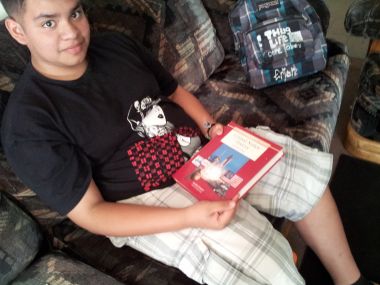Introduction

(Susan Ferriss/The Center for Public Integrity)
Following inquiries that led to the Center for Public Integrity’s July publication of “Throwaway kids” — documenting how disciplined California children are forced to study alone at home — education officials inquired how a rural teen was doing, but provided him no assistance other than a few books.
“He still can’t go back to school,” said Nereida Vasquez, the mother of Erick Araujo, who was 13 and in 7th grade when removed from regular school last year on a disciplinary charge in Lost Hills, Kern County, in California’s Central Valley.
Erick’s mother was forced to put him on home study because he was assigned to a county alternative “community school” that is nearly 40 miles away from Lost Hills.
Vasquez’s farmworker job does not allow her time to drive him to and from a school that far away every day. It would also cost $400 a month in gas. But Erick must be offered, under California law, an education — or Vasquez could be legally liable for her son being truant.
Alternative school officials suggested independent study, which means studying at home, alone, four out of five days a week, and seeing a teacher only 4 ½ hours a day once a week, when his mother can drive him. Vasquez believes Erick is getting an insufficient education.
But as long as Erick is officially enrolled at the county community school — while on independent study — that system still receives full attendance-based funding for Erick as if he were attending classes every day. It’s the same story for two-thirds of the more than 4,000 other students put on independent study in Kern’s community system last year.
Other counties in California also employ independent study for tens of thousands of other students enrolled in California’s county community schools. But the state does not require educators to report how many of their students are on these home-study regimens or track individually how they fare.
In addition to Vasquez’s continuing concerns, other families in Kern are starting to complain that their children are being removed for alleged infractions too hastily and then essentially given no choice but to drop school completely.
Speaking on the Spanish-language radio show Radio Bilingue, Martha Cisneros, a mother in the Kern city of Arvin, said her son, 15, was removed from school last spring semester on suspicion of drug use. She said she had her son tested — the test was negative — but the school rejected her evidence.
Her son stopped going to school because the family had no way to drive him to a county community school at least 20 miles away. Cisneros sought help from a community organizing group, the Dolores Huerta Foundation, which helped her send a letter of protest in June to Kern high school administrators.
“I’ve got him in the house,” she said. “I don’t want to take him to work because he’s too young.”
In the letter, which was given to the Center, Cisneros said she signed forms in English and in Spanish she couldn’t understand that gave her consent to transfer her son, and that when she called the community schools she was told to call she was initially told there wasn’t room for him.
Her letter, asking that her son be allowed back into Arvin High School, says the family will face a “perhaps impossible burden” to try to get her son to a county alternative school that’s in Bakersfield, 20 miles distant.
Arvin High expelled 56 students during one recent year, and as the Center report explained, the best that some other parents could do was put their child on home schooling and one-day visits with a teacher.
On Aug. 14th, the California state Assembly Education Committee is scheduled to hold a hearing on a number of bills related to schooling, including a proposal to tighten up the enrollment of students in alternative schools.
Sen. Ricardo Lara, Democrat of Bell Gardens, near Los Angeles, said his bill, SB 744, will address some concerns about transfers. It would, as the Center explained, require that districts cover extra transportation costs for some kids (although not expelled kids) if they exceed a parents’ normal spending to get their children to school. It would also strengthen parents’ rights to revoke some agreements to transfer their children to alternative schools.
Travel complications for kids kicked out of regular school are not just a rural problem.
Lawyer Zoe Rawson of the Labor-Community Strategy Center, which provides court aid to Los Angeles-area schoolchildren, said she represented an 11-year-old special-needs boy last year whose Spanish-speaking mother was urged to transfer him to a community school seven miles from his home. No one in the family could go with him, so he rode a public city bus alone, putting his safety at possible risk.
Rawson filed a complaint with the state and the boy was returned to his home school and given proper testing and a learning plan.
In Kern, Erick has received visits from migrant education specialists, who are tasked with aiding farmworker children whose parents often move about as crops are harvested. They declined to speak with the Center, referring questions to Steve Sanders, chief of staff for the Kern County superintendent of schools.
“We agree that Erick is missing out by not attending school in a classroom environment and we hope that Erick’s family is able to provide a way for him to be in school on a regular basis. That is why classroom instruction is always offered as the preferred approach,” Sanders said in an email.
He called independent study — which two-thirds of the county community students are on — a learning method of “last resort.”
Parents choose it, Sanders said, often because of travel problems, but also because of “gang turf issues, lack of family support, behavioral issues where classroom instruction is not an option for the safety of other students.”
Attorney Tim McKinley of the California Rural Legal Assistance legal aid group in Kern has represented Erick and other children in expulsion hearings. McKinley said he was not only concerned about Kern’s high expulsion rates, as the Center has reported, but also the widespread use of independent study.
A California education professionals group, the California Association of Business Professionals, held a workshop in Kern in November 2011 on the legal requirements of short-term and long-term independent study and how to ensure that per-pupil, average-daily-attendance funding (ADA) is not lost.
“A properly implemented independent study program provides a valuable educational alternative to pupils and an ADA increasing strategy for schools,” the workshop said.
McKinley said if independent study were used more sparingly it would bother him less, but given how many students are placed on self-study the workshop announcement struck him as a way “to make buck.”
“It’s beyond troublesome,” he said.
Read more in Education
Juvenile Justice
In nation’s richest farmland, some workers’ kids get no education at all
Kids who have been disciplined cannot get to ‘alternative’ schools that are miles away
Juvenile Justice
Getting adults on board for alternatives to locking up kids
Evolving network urges new ideas to prevent kids from becoming costly adult offenders



Join the conversation
Show Comments